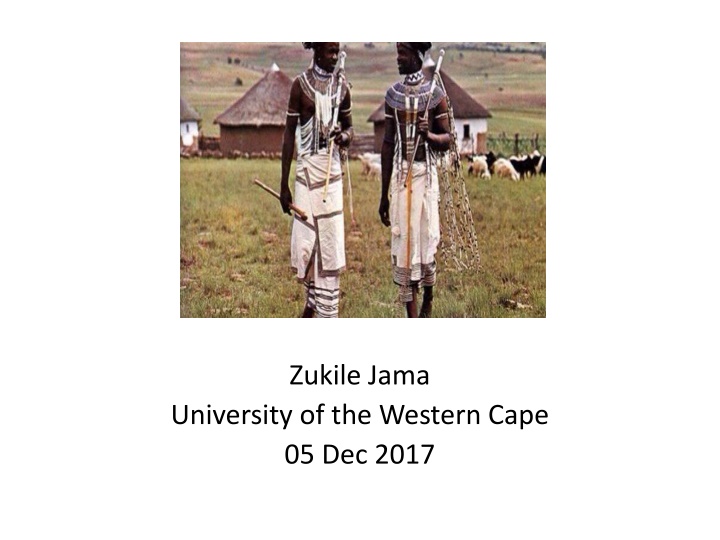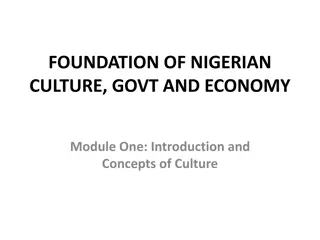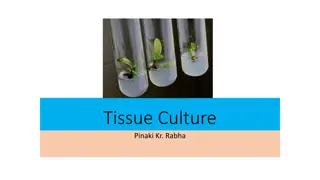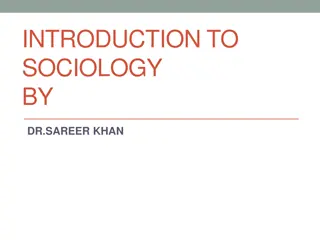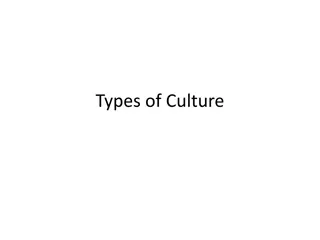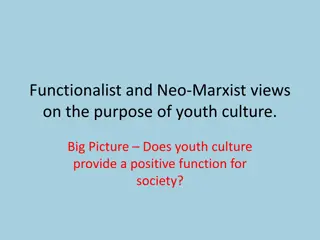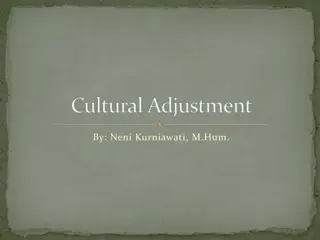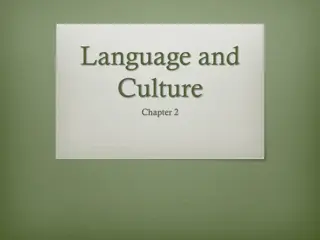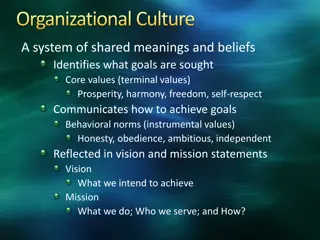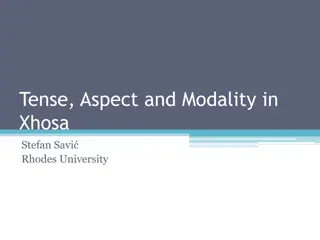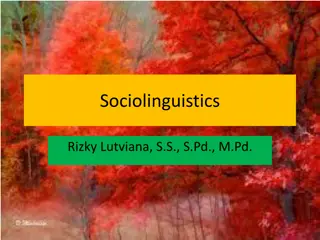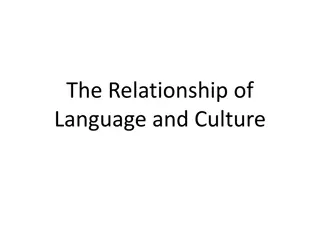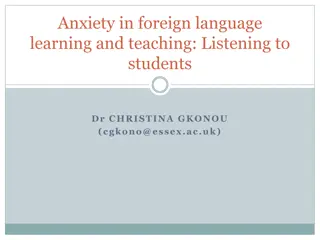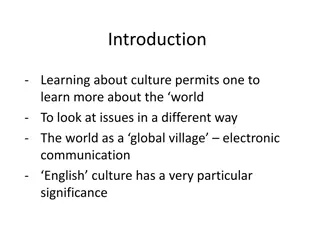Insights into Xhosa Language and Culture
Xhosa, the second most spoken language in South Africa, is part of the Nguni sub-family of the Bantu languages. It has a rich history, with various dialects and a unique structure based on noun classes and concords. The language has undergone significant transformations, such as being written in a Roman-based orthography by missionaries. Xhosa is characterized by an agglutinative nature, a simple vowel inventory, and a complex system of consonants. Understanding Xhosa language and phonology provides valuable insights into South African culture.
Download Presentation

Please find below an Image/Link to download the presentation.
The content on the website is provided AS IS for your information and personal use only. It may not be sold, licensed, or shared on other websites without obtaining consent from the author.If you encounter any issues during the download, it is possible that the publisher has removed the file from their server.
You are allowed to download the files provided on this website for personal or commercial use, subject to the condition that they are used lawfully. All files are the property of their respective owners.
The content on the website is provided AS IS for your information and personal use only. It may not be sold, licensed, or shared on other websites without obtaining consent from the author.
E N D
Presentation Transcript
Zukile Jama University of the Western Cape 05 Dec 2017
Xhosa is the second most spoken language after Xhosa and is one of the eleven official languages of South Africa spoken in 5 of the 9 provinces (viz.. the Eastern Cape, Western Cape, Free State, Northern Cape and Gauteng). Xhosa1 consist of a population of approximately (8 154 258) people in South Africa (2011 census) Its Dialects are Gcaleka, Ndlambe, Gqika, Thembu, Bomvana, Mpondomse (Mpondomise), Mpondo, Xesibe, Rhathabe, Bhaca, Cele, Hlubi, Mfengu. 15% of is vocabulary is estimated to be of Khoi (Khoisan) origin) It represents the most southwestern branch of the Nguni sub-family of the Bantu languages. The Nguni group is divided into two sub-groups: the Zunda and. Tekela sub-groups. IsiXhosa, siNdebele and Zimbabwe Ndebele are languages belonging to the Zunda sub-group. 1. 2. Contestable For stylistic reasons and consistency, the term Xhosa rather than IsiXhosa will be preferred in the course of this dissertation.
Map of South Africa . According to the map of South Africa above, Xhosa is mostly spoken in regions 1 and 9 although a contingent of speakers is found in 2, 3 and 6 as well
written form Xhosa was transformed to a written form by the missionaries. This happened in 1823. In 1821, John Bennie, a missionary settled among the Xhosa people in a place known as Tyhume, in Alice Xhosa has a Roman-based orthography Conjunctive wring system: peripherous words such as articles and prepositions do not find themselves into the structure of Xhosa. This means what appears as many words in English may be a single word in Xhosa (shackter) eg: I am speaking Ndiyathetha .
Language profile Xhosa is an agglutinative language, that is, grammatical information is conveyed by attaching prefixes and suffixes to roots and stems. Um-ntu, ubu-ntu, isi-ntu, uku-mntw-isa, in-to As in all Bantu languages, the structure of isiXhosa is based on two principles: (a) the system of noun classes, and (b) the system of concords (agreement).
The phonology of Xhosa The phonology of Xhosa is characterized by a simple vowel inventory and a complex system of consonants. Most syllables end in a vowel There are five vowel phonemes viz: a as in a in arm amanzi (water) e as in e in leg ewe (yes) i in i in ink idolo (knee) o as in o in door umlomo (mouth) u as in oo in ooze umntwana (child) Front Central Back u, uu , Close Mid Open i , ii , a, aa Vowel length distinguishes word meaning Tone
Consonants Xhosa has a complex system of consonants, including some uncommon ones. 1. Clicks Sounds Clicks are written using c for the dental clicks, x for the lateral clicks, and q for the alveolar clicks. Click Example Pronunciation C This click is produced by pressing the front of the tongue where the front palate and the front teeth meet. X This is produced by sucking the side of the tongue to the side teeth and palate pulling it away quickly. Q cela (ask) uxolo (sorry) qala (start/begin)
Labio- dental Postalveolar/ palatal Bilabial Dental Lateral (Post)alveolar Velar Glottal voiceless plain k (c) k (x) k (q) voiceless aspirated k (ch) k (xh) k (qh) voiced breathy g (gc) g (gx) g! (gq) voiced nasalized (nc) (nx) ! (nq) Clicks voiced breathy nasalized (ngc) (ngx) ! (ngq) voiceless ejective p (p) t (t) x c (ty) k (k) voiceless aspirated p (ph) t (th) c (tyh) k (kh) voiced breathy b (bh) d (d) (dy) g (g) Stops implosive (b) voiceless f (f) s (s) (hl) (sh) x (rh) h (h) Fricatives voiced breathy v (v) z (z) (dl) (gr) (hh) voiceless ejective ts (ts) t (tsh) kx (kr) voiceless aspirated ts (ths) (thsh) Affricates voiced breathy (j) voiced plain m (m) n (n) (ny) (n ) Nasals voiced breathy m (mh) n (nh) (nyh) voiced w (w) l (l) y (y) Approximants voiced breathy w ( wh) l (lh) y (yh)
Personal pronouns SINGULAR FORM PLURAL FORM m n a Ndi I Ndiyaqonda (I understand) thina Si We Siyaqonda (do we understand) 1st person Personal pronouns Have corresponding prefixes w e n a U You Uyaqonda? (rising tone) (do you understand?) nina Ni Niyaqonda? (Do y all understand?) 2nd person Y all y e n a U s/he Uyaqonda (low tone) (do you understand) bona Ba They Bayaqonda (They understand) 3rd person y o n a I It Iyasebenza (It works) zona Zi They Ziyasebenza (They works) 3rd person (things)
Nouns Xhosa nouns belong to 17 different classes, roughly based on semantic categories, e.g., there are classes for human beings, animals, plants, objects of various shapes, etc. However, not all noun classes can be so easily defined. Marking of the plural number depends on the noun class. For example, umntu person and abantu people, umama mother and oomama mothers. There are no cases.? There are no definite or indefinite articles. Gender is not marked.? Adjectives, possessive pronouns and demonstratives agree with the noun they modify in class and number. eg Poss: Umntu wam u+am Adj: omhle um+a+hle Dem: lo la+u(m)
Noun classes Class 1 2 1a 2a 3 4 5 Prefix Um(u)- aba- u- oo- um- imi- I(l)i- added to 1 syllable i- more than 1 Noun umntu abantu ugqirha oogqirha umnwe iminwe iliso idolo Translation person people doctor doctors finger fingers eye knee 6 7 8 9 ama- isi- I(z)i- In(i)- ama-dolo isisu izisu intso intloko impumlo inaliti knees stomach stomachs kidney head nose needle/injection im- i- 10 izin- one syllable iin- iim- ii- izintso iintloko iimpumlo iinaliti kidneys heads noses needles 11 U(lu)- to one syllable Plural in class 10 ubu- Uku-/ukw-/uk- ulusu u skin 14 15
Verbs Xhosa verbs are highly inflected The Xhosa verb has one important characteristic, viz that it consists of a root or a radical which carries its basic meaning. This root, by itself, cannot be used in the language. Only after certain prefixes and suffixes have been added to this root, does it acquire functional value an example, the composition of the verb In the sentence Um-ntwana u-ya-wa-sel-a ama-nzi Det-child he-pres-it-drink det-water Sing-child SC-TM-OC-VERB-(TA) PL-water the child drinks water
Different suffixes, also called verbal extensions or verbal derivative suffixes, are added to the root in order to enlarge the applicability of the basic meaning to different contexts -FUNDa means "learn" or "read (neg: a-ndi-fund-i) -FUNDwa means be learnt" or "read FUNDeka means "legible" or "readable -FUNDela means "learn/read for'" -FUNDile means "have learnt" -FUNDisa means "cause to learn/teach/instruct" -FUNDana means "learn/read together" -FUNDisana means "teach one another
Tense POS SF NEG Pres Ndi-ya-bon-a Ndi-bon-a inja A-ndi-bon-i Pst fut Ndi-bon-ile Ndi-za ku-bona Ndi-bon-e Ndi-zo-bon-a A-ndi-bon-anga A-ndi-zi-ku-bon-a remote Nd-a-bon-a Khange/zange ndiibon-e A-ndi-zange
The verb to have: Na- expresses and ( to join nouns) na+noun eg: na+uZola=noZola Na- expresses together with/ as well as/too ( joined to noun or pronouns) Na+abbr pro eg: na+yona=nayo -na- expresses has/have ( requires SC-Na+ noun)i.e to be with something. Na- operates like a verb Ndi-ne-ntloko Subj pref-na-intloko
Vowel Rules In Xhosa Xhosa does not allow two vowels next to each other. We have seen this with the negative formation. In this instance, instead of inserting a consonant to separate the two vowels, the vowels coalesce/combine. These are the rules: a+ a = a a+ i= e a+ii=ee a+u=o a+oo=oo Lala ngomqolo (INSTR) Ndi-ne-ntloko (HAVE/ASS/CONJ)
The Locative THE LOCATIVE e____________ ni, e-, ku-, kwa e-msebenzin i at work (umsebenzi :work) e-khaya, ekhayeni (lam)at home (ikhaya :home
